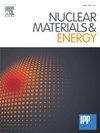Preparation and characterization of marker graphite tiles for PWI research of HL-3
IF 2.3
2区 物理与天体物理
Q1 NUCLEAR SCIENCE & TECHNOLOGY
引用次数: 0
Abstract
In tokamaks, to understand the erosion and deposition pattern of plasma facing components (PFCs) is crucial for the study of plasma wall interaction (PWI). In this study, a set of dedicated marker graphite tiles consisting of substrate material same as the PFCs of HL-3 tokamak, an interlayer of 0.5 μm Tungsten (W) with width of 50 mm employed as marker, and a 5 μm thick with width of 30 mm carbon (C) marker layer on top, were designed and prepared for the PWI research. The magnetron sputtering technique was employed to make the marker layers including W and C layers. The scanning electron microscopy (SEM) and energy dispersive x-ray spectroscopy (EDX) were used to study the surface morphology, elemental composition and layer structure characterization of marker graphite tiles. The Laser-induced breakdown spectroscopy (LIBS) was employed to perform elemental analysis along the depth direction of the C-W-C structure and W-C structure on the marker graphite tiles. Moreover, during the manufacturing process of marker graphite tiles, glass slides were used to be coated simultaneously with graphite and then measured by profilometer in order to evaluate the thickness of the coating. The cross-section of the marker graphite tiles measured by SEM revealed an average W interlayer thickness of 0.71 μm and an average C layer thickness of 4.75 μm. The LIBS results indicate that the thickness information of the C-W-C structure and the W-C structure is consistent with the findings from SEM analysis. The marker graphite tiles have been installed in HL-3 to perform the PWI studies including the C and W erosion, impurity deposition and material migration via surface element analysis and layer structure analysis of the marker graphite tiles in the next experimental campaign.
求助全文
约1分钟内获得全文
求助全文
来源期刊

Nuclear Materials and Energy
Materials Science-Materials Science (miscellaneous)
CiteScore
3.70
自引率
15.40%
发文量
175
审稿时长
20 weeks
期刊介绍:
The open-access journal Nuclear Materials and Energy is devoted to the growing field of research for material application in the production of nuclear energy. Nuclear Materials and Energy publishes original research articles of up to 6 pages in length.
 求助内容:
求助内容: 应助结果提醒方式:
应助结果提醒方式:


